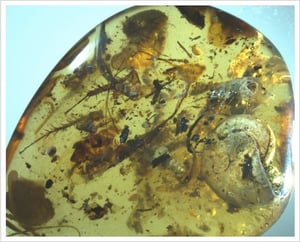A postcard sent 99 million years ago: this is exactly what the extraordinary piece of amber is like that was found in the north of Myanmar (or Burma, to use the “old” name) and studied by researchers from the Nanjing Institute of Geology and Palaeontology of the Chinese Academy of Sciences (NIGPAS), who published the results of their investigations in the scientific journal PNAS, together with several photographs.
In fact, in this Burmese amber you get a very clear picture of the numerous species that were alive during those very remote times, with several characteristics that are very rarely found in specimens of this kind: in particular, the presence of several marine organisms, including an ammonite (a type of mollusc that went extinct 65 million years ago), which is usually not present, given that the amber is a resin originating from land-based plants.
The list of species found in the little “pebble”, which is only 33 mm long, 9.5 mm wide, 29 mm tall and weighs 6.08 grams, is long and surprising: 40 marine and terrestrial species were trapped in addition to the ammonite, the majority of which being mites. And then, as far as the terrestrial species are concerned, there were also spiders, millipedes, cockroaches, flies and wasps. As for the marine species, on the other hand, the researchers discovered different kinds of molluscs.
The researchers used a micro-CT to better understand what remained inside the amber, and they managed to obtain high resolution three-dimensional images, very important for the classification of this kind of miniature prehistoric zoo and the identification of the ammonite – which is an example of a juvenile Puzosia (a kind of extinct relative of the squid), found in the mid-Cretaceous era, i.e. about 99 million years ago.
With regard to the reasons why an ammonite was discovered in a drop of amber, the most probably explanation, according to the Chinese palaeontologists, is this: the amber came from a tree that produced resin and that grew, probably, close to a beach. Various terrestrial animals got trapped when the resin was still on the trunk. It then fell on the sand, embedding the ammonite, as well as the sand, and reappeared before the surprised eyes of the researchers from Nanjing 99 million years later.
Photo credit: NIGPAS

